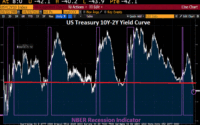Growing Pile of Distressed Debt Signals Coming US Default Wave
(Bloomberg) — A heap of distressed debt is expanding in the US corporate bond market and investors worry that a burst of defaults will follow.
Most Read from Bloomberg
The amount of dollar-denominated bonds and loans trading at levels indicating distress is the largest since September 2020, reaching $271.3 billion last week after five straight weeks of growth, according to data compiled by Bloomberg.
Companies that binged on low-cost borrowing in recent years are facing the prospect of refinancing at exorbitant yields — if they can find any investors — as the Federal Reserve raises rates to battle persistent inflation, threatening to push the economy into recession. Some market participants see distress leading to default, and for some companies, bankruptcy.
“You’re going to see a lot more distressed companies borrowing at a much higher rate,” said Jordana Renert, a restructuring lawyer with Lowenstein Sandler. “I don’t think it’s going to be everybody falling off a cliff — I think it’s going to sort of be a slow movement, an uptick in the bankruptcy cycle.”
The growing volume of troubled debt — defined as bonds trading at yields at least 10 percentage points above Treasuries, or loans changing hands at less than 80 cents on the dollar — shows investors are demanding a higher return for holding on to the debt of risky enterprises.
A case in point is Carnival Corp., with more than $8 billion of debt obligations trading at distressed levels, according to data compiled by Bloomberg. The cruise company managed to sell $2 billion of bonds earlier this month to refinance some of its debt, but paid a yield of 10.75%. Carnival last year sold bonds at yields as low as 6%.
To be sure, the supply of distressed debt is still a fraction of the almost $1 trillion peak level in 2020, when the coronavirus pandemic brought global commerce close to a halt. This time, the pile of troubled borrowers has been slowly building for months — hinting at an eventual surge of defaults.
Jonathan Lavine, co-managing partner at Bain Capital, says corporate default rates could rise to the 3% range within the next year. “It’s about 1.5% right now.” he said in a Bloomberg Television interview on Thursday. “We think that that could double in the next year or so.”
Many borrowers are huddling with advisers and creditors on ways to manage their debt loads. Envision Healthcare Corp., a hospital staffing company owned by KKR & Co., this year reached a creative — and aggressive — deal with some lenders to shuffle assets and raise fresh money. Almost $8 billion of the company’s debt still trades at distressed levels, according to data compiled by Bloomberg.
And in the universe of companies with at least $50 million of liabilities, just 75 filed for bankruptcy in the US this year compared with more than 100 at this point last year, and more than 200 in the same period in 2020, according to data compiled by Bloomberg.
But insolvencies will eventually ramp up, starting with a slow trickle, said Stacy Tecklin, a lawyer at Glenn Agre Bergman & Fuentes.
“What we’re seeing is a lot of behind-the scenes-restructuring talks, lowercase “r,” to avoid the bankruptcy court process,” Tecklin said. “Winter is coming.”
Most Read from Bloomberg Businessweek
©2022 Bloomberg L.P.
[ad_2]
Source link


